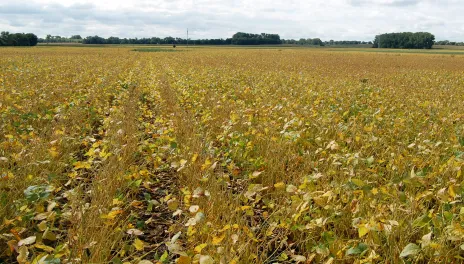Fall Weed Survey in Soybean
Fall Weed Survey in Soybean
Howdy! I hope you’re all doing well.
No rain fell in the past week! Temperatures were above normal for the past week.
Most crops have reached maturity. Dry bean harvest is progressing and soybean harvest should have begun when you read this.
I conducted my annual weed survey in soybean on September 9, 2021 to evaluate weed control in soybean fields at the end of the growing season. I drove 73 miles around the county through parts of 13 townships. I evaluated weed control in 109 soybean fields along this trip covering approximately 24,000 acres.
The weed control was evaluated as weed-free meaning no weeds were present in the field, a 1 for occasional plants, a 2 for large patches (a patch(es) of 8 or more plants of individual species scattered in the field), or a 3 for widespread (numerous patches or individual plants of the species across the field). Weeds were only counted if two or more soybean plants surrounded a weed. I did not evaluate the saline areas except for kochia.
Only 14 percent of fields were weed free! This is a decrease of 7% from the 2020 survey. I also kept track of the number of fields that had only three or fewer broadleaf plants because they were nearly weed-free. Only 12% of fields were nearly weed-free. Last year that number was 27%. So, in 2021 only 26% of fields were weed-free or nearly weed free of broadleaf weeds compared to 48% in 2020.
This year’s number one weed was again kochia. Kochia was present at any level in 78 percent of soybean fields compared to only 35% in 2020. It was present at a level of 1.4 out of three with ten and nine percent of fields present at a rating of two and three, respectively. For kochia I evaluated the density of plants within the saline areas where no soybeans were present. In 61 percent of the fields, kochia was worse in the saline areas as compared to the soybean area of the field. In 39% of fields the density of kochia was the same in the saline area as compared to the soybean area. In 22 percent of fields the amount of kochia in the soybeans were rated a 1, but was rated a three in the saline areas.
The second most common weed in soybean fields in 2021 was waterhemp. Waterhemp was present at any level in at least 16% of fields compared to 14% in 2020. The waterhemp was present at a level of 1.4 out of three compared to 1.2 out of three in 2020. Having only a two percent increase of waterhemp present at the end of the soybean growing season compared to last year is really a win, but it did increase from a density standpoint. Waterhemp is difficult to control and we do not want it. If you have a chance to pull the plants and take them out of the field prior to harvest you will have fewer plants next year. One reason these plants could be present is due to resistance to herbicides.
The third most common weed in 2021 was barnyardgrass at 11%, which compares to 17% in 2020. Barnyardgrass was only present at a level of 1 (occasional).
The fourth most common weed in 2021 was common lambsquarters at nine percent compared to 17 percent in 2020. The common lambsquarters density was rated at 1.4 out of three.
The fifth most common weed in 2021 was redroot pigweed at seven percent compared to just two percent in 2020. The density of redroot pigweed was one out of three.
The sixth most common weed in 2021 was volunteer corn at six percent compared to ten percent in 2020.
The next most common weeds in 2021 are Powell amaranth and marshelder at five percent each. This compares to ten and four percent, respectively in 2020.
The following weeds were present at less than five percent of fields in 2021: marestail, common ragweed, green foxtail, stinkgrass, foxtail barley, biennial wormwood, curly dock, and common milkweed.
Get out and pull all surviving weeds before harvest, especially kochia and waterhemp.

